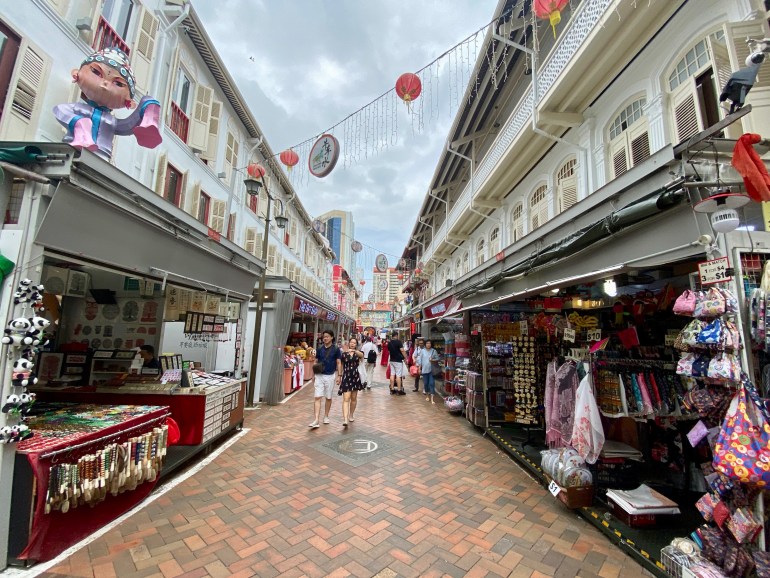Do you need some ideas on how to spend your next layover? What about taking a secret food tour in Singapore? It’s a three-hour guided tour in Chinatown with a very passionate local who will tell you everything about Singapore’s rich history to their culture on food.
I don’t want to ruin the element of surprise, so instead of telling you the names of the places we ate, I will let you in on a few secrets I learned on my own. Shh! Don’t tell anyone, though.
I arrived in Singapore and literally had one hour to zip through customs, collect my luggage, drop it off at the baggage storage, and hop in a 20-minute taxi ride to get to our meeting point in Chinatown. I asked my taxi driver on my way where his favorite hawker was and he couldn’t give me a definitive answer. His answer was, “You go to different hawkers for different things.” Can I get more intel, please? He really couldn’t. At just one hawker centre alone in Singapore, there are 250 hawkers. Not 25, but 250! That’s enough to try something new almost every day of the year.
I make it with time to spare. My guide, Natalie, is holding an orange folded umbrella ready for the showers that were predicted in this hot, humid weather.

THE TOUR
Disclaimer: let me begin by saying this is not a tour for individuals with dietary restrictions nor is it a good time for you start your diet. Flexitarians, like me, is okay!
Sample #1

BAK KWA (Chinese Pork Jerky)
The tour begins with our first stop trying Singaporean bak kwa that translates to Chinese BBQ meat or as Americans like to call it, “jerky”. I get my appetite rolling with a pork golden coin that tastes similar to a breakfast sausage only more jerky-like. Traditionally, they used to charcoal grill it and use it to preserve meats during the lean months. Nowadays, it’s simply prepared over gas with spices, hoisin sauce, molasses, honey, salt, and pepper. Bak kwa is available 365 days a year but is more commonly consumed at festivals by the Chinese. During Chinese New Year, they go crazy over it and will buy 200 lbs (100 kg) or more of jerky even with the double markup.
Sample #2

CURRY PUFF
After sampling a golden coin, we walked across the way to a chain restaurant that’s been open since the 1950s and ordered (a food legacy left behind by the British) the puff pastry. Only we tried the Singaporean upgraded version, the curry puff.
It’s a perfect opportunity to sit down in A/C for a few minutes while I eat my curr-ated empanada and listen to Natalie divulge more into more Chinatown’s history. We observe some of the shophouses (also created by the British) and Natalie elaborates more on how they used to live in the 1950s. Sometimes there would be as many as 2 single-stacked bunks with two on each and the other two on the floor. The area was known to be full of diseases, unhygienic, and very poor. Because it was usually men that came over from China to support their families, it wasn’t unlikely to find prostitution, opium bars, and gangs.
In 1983, Singapore decided they were going to either tear down all the shophouses or restore it and turn it into a commercial area. Obviously, they chose the latter. You will not find anyone living in Chinatown these days, but the history is absolutely fascinating.
Singapore essentially thrived off of the only two resources they had, which were the harbor and the sun. They had this dilapidated, unwanted land and turned it around into one of the cleanest, wealthiest, and most progressive nations in the world in such an incredibly short amount of time – since 1983! Absolutely impressive.
It’s no wonder there’s so much curiosity from the states on how they managed to create 17 reservoirs, one of them coming from the marina, and all through desalinization. There are more trees than people and 90% of citizens own their own homes, likely in high-rises. Not rent, but own. Then you have the top 4% who actually own land.
HAWKER CENTRE #1
Chinatown
My guide first points out the health food ratings of A and B. These are mostly created for foreigners so they know it’s safe for them to eat, but look at where all the lines are. I observe and see all the locals are lined up at the B-rated stalls. Their B-rated explanation: they’re spending more time cooking than cleaning. Ha. So, the secret is to not let the B-ratings deter you from eating there next time.
Sample #3

HAINAN CHICKEN RICE
This is a national dish but how do you know if you’ve found a good one? I asked and am told the main characters are not the chicken. The secret is in the rice and the chili. A good Hainan chicken rice will always be served with three things: ginger for aromatics, the chili for kick, and the duck soya sauce for sweetness. The rice should be served oily and made with stock or rendered chicken fat so it tastes like ginger and garlic and served hot while the chicken should be served at a warm temperature.
The chicken is typically poached. The first thing is to prepare a big pot of stock with bones, meat, and vegetables. Bring stock to boil, lower heat to a minimum, then the chicken is steeped for the next 2-3 hours. Afterward, dunk into ice-cold water (to stop it from cooking and to make the skin a springy texture). Once it’s dunked, remove, and air dry it.
Sample #4

FRIED HOKKIEN PRAWN NOODLES
This rice noodle dish is a braised noodle that belongs to the Hokkien clan. I guess that’s how they define some of their dishes by the clan it was derived from. The way that this is prepared is to first stir-fry the noodle, then add a prawn-based stock, add any additional seafood, and then braise it for about 10 minutes by covering the lid so it can soak up all the flavor. Don’t forget to add the must-have condiments and pair it with a local lime and local chili.
Sample #5

OYSTER CAKE
There are only three stalls on the whole island to find the oyster cake. It’s a very traditional battered patty stuffed with minced pork, shrimp, oyster, celery, fresh herbs, and seasoning. If the next generation decides not to continue with it, there will be no more.
I’m watching the process of them almost ladling a shallow spoon with batter and then throwing the meats on top before adding on the last layer of batter on top. The woman who works there drops it into a deep-fry and when it’s removed, the man I’m assuming is her husband, cuts it into fours for me so it’s easier for me to eat.
I take one bite into it and it’s still a little too hot to sink my teeth in but I’m enjoying the umami in the background and the aromatics from the fresh herbs. A good oyster cake will always be served Southeast Asian style with a chili sauce. Yum! This can definitely replace spring rolls. Proceed with caution though. I’m told that from my guide’s experience, Americans generally aren’t fans of the oyster or pork. This might have been my favorite hawker dish though.
I’m full and I’ve just sipped on a Tiger beer so we’re ready to walk. We pass another Michelin-rated hawker for Hainan chicken but she whispers to me, “The same chef cooked our Hainan Chicken and there were no lines.” I think I know who’s winning here. That’s why we’re on the Secret Food Tour. It’ll be our secret.
HAWKER #2
Chinatown Complex
Remember how I mentioned 250 stalls in one area of food? That’s this one. Sure, I can look for the long lines and guess what to order – but it’s so much nicer and convenient to have local tips. What I learned is that many locals will come for breakfast, again for a 10:00 am snack, again for lunch, then 4 pm high-tea, and dinner. How does everyone stay so thin? They eat light and their food isn’t so rich.
Sample #6

CHENDOL (Shhh!)
I’m giving away their signature secret dish and it’s called, Chendol. It’s an Indian shaved ice dessert with a mixture of a sweetened wet bean, coconut milk, rice flour, pandan extract, and lots of palm sugar. Admittedly, it didn’t look too appetizing and sounded way too sweet but I really enjoyed this! It’s airier than expected.
Sample #7

FRIED CARROT CAKE
While I’m cooling down on my dessert, Natalie grabs a (not-so) carrot cake from nearby. Let’s first begin by saying it’s not the carrot cake you’re probably thinking of. Fried carrot cake (without carrots) gets its name because it’s made of daikon radish. When the Chinese look at the daikon it looks like a white carrot so in Mandarin they call it, “white carrot”. The daikon is then shaved, mixed with rice flour, and then steamed into a pudding-like texture. Afterward, it is cut into squares and then crumbled with pickled radish in the egg.
If you order this, don’t forget to add their staple condiment: chili sauce.
Sample #8

YUAN YANG PENG (Ice Coffee & Tea with Condensed Milk)
After all that eating, I’m stuffed. So much so that I packed my freshly-made Indian prata with curry sauce to go. I need energy and what a perfect way to get my energy back up by finishing our tour at a very traditional coffee shop with a mini-museum. Natalie makes me learn how to pronounce Yuan Yang Peng and has me order it myself at the counter without messing it up too much.
Sample #9

KAYA TOAST
Toast is a legacy left by the British, so what did the Singaporean-Chinese do? Make it better. What makes a good Kaya toast is that instead of using a marmalade like the Brits, the locals made their own jam with coconut milk, egg yolk, tons of sugar, and pandan extract.
Our three-hour secret food tour comes to an end at the coffee shop with some light conversation about our her upbringing and some old generation views. I also learn Natalie is also a professional baker and was able to educate me on some key things to avoid when shopping for pastries.
This is my fourth trip to Singapore but I learned more in these few hours than I did all three previous trips combined. What I superficially labeled, “a shopping destination” or stereotyped by the movie, “Crazy Rich Asians” is now appreciated by the perseverance and obstacles they’ve overcome. It was most definitely a perfect way for me to spend my layover.
If you’re interested in booking a tour with them, I’ve included their links below:
https://www.instagram.com/secretfoodtours/
https://twitter.com/secretfoodtours
https://www.facebook.com/secretfoodtours/







2 Comments
This looks amazing. I’ve done a few of their food tours, but none of the ones in Asia. I also haven’t made it to Singapore yet, so this definitely goes onto my bucket list for next year!
Super happy to inspire you! Let’s hope we all get to travel more in 2021.